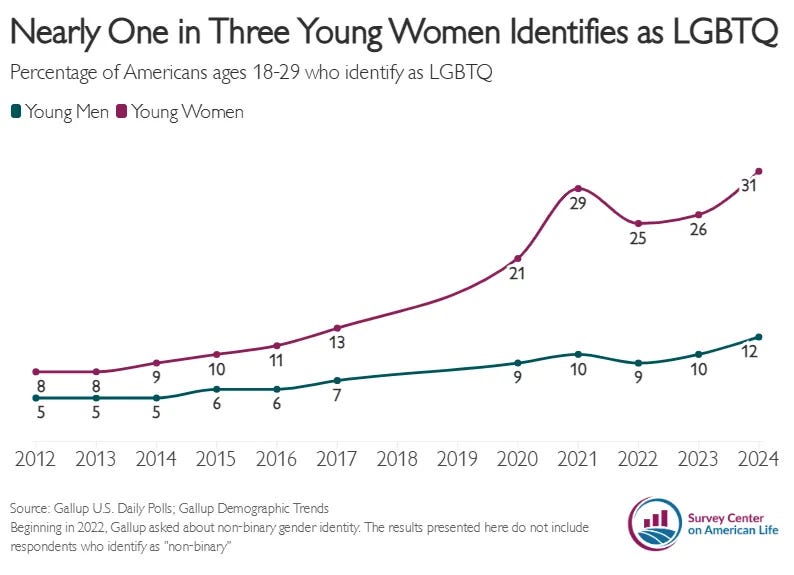B & Q (but not LGT) as Social Contagion
Pro-natalists don't need to be concerned about same-sex acceptance.
Note: I may start experimenting with shorter posts like this. Last month, I included a few extended stream-of-consciousness arguments in my links posts, but I suspect many people didn’t read them because they didn’t also want to sit through my tedious opinions about Jim Belushi’s 25-year-old sitcom and the Cato Institute. I’ll keep writing long-form pieces at approximately the same frequency as I do now, but I might also publish something like this once in a while.
I read an interesting article on Substack this morning, “What’s Behind the Rapid Rise in LGBTQ Identity?”
Between 2012 and 2024, the percentage of women ages 18-29 who identify as LGBTQ increased nearly four-fold, while the percentage of men more than doubled.
It’s common to hear a “born this way” explanation — fewer people are closeted now than in the past — but the authors say this doesn’t work:
Increasing social acceptance of homosexuality does not explain why the rise in LGBTQ identity is primarily occurring among young liberal women — are they uniquely tolerant or supportive? If anything, the views of older Americans on LGBTQ issues have shifted more dramatically than young adults, but they are not demonstrating the same rise in LGBTQ identity. In fact, there is little change among older cohorts.
A social contagion hypothesis is much more compelling:
Young women are significantly more active on social media than young men, and given gendered habits online, they are more likely to be exposed to accounts that feature LGBTQ topics. Our research also shows that young women who identify as gay, lesbian, bisexual or queer are much more active on social media platforms than women of the same age who are straight.
I think that’s right, but the answer is a bit more complicated.
One data point that gets obscured in these debates is how much of the rise in LGBTQ identity is bisexuals, non-binaries, and nondescript “queers” — people who don’t have to change much about their behavior to identify as a gender or sexual minority — and not gays, lesbians, and trans. As of 2023, over 76% of the increase in LGBTQ identity from the Silent Generation to Gen Z was due to people increasingly identifying as bisexual or “Other LGBTQ.” This is also true of 79% of the increase from Boomers to Gen Z, 80% from Gen X to Gen Z, and 80% from Millennials to Gen Z.
I think Bryan Caplan offers the best explanation here:
[T]he more openly LGBT people you socialize with, the more likely you are to consider giving their lifestyle a try — especially if the costs of trying are low.
This is especially clear for the orientation with off-the-charts growth: bisexuality. The current cost of “trying” bisexuality is low. You barely have to act on it. Even today, self-identified bisexuals rarely marry — or even co-habit — with same-sex partners. So why adopt the label? To live in communion with LGBT friends… even if you live a nearly-straight lifestyle.
This seems to jibe with a lot of our evidence about who is having sex with whom. If “bisexuals” were all changing their behavior and not just their identity, you’d expect there to be about as many self-identified bisexual Millennial men actively seeking to have sex with men as there are self-identified gay Millennial men seeking to have sex with men. Yet, in a 2015 survey of Grindr users (mostly Millennials, although unfortunately n = 92) only 21.7% identified as bisexual. So it looks like a lot of bisexuals are just taking the label to fit in.
This might be disappointing to the few LGBTQ activists who still cling to the discredited “born this way” hypothesis. But there’s a silver lining here: It suggests that people concerned about declining fertility — some of whom are growing increasingly conservative on homosexuality — shouldn’t be very concerned about society’s acceptance of same-sex activity, since it’s just changing how people identify, not how they behave. Between 1972 and 2014, the number of people who reported at least one same-sex experience in their lifetime1 increased from 4.5 percent of men and 3.6 percent of women to 8.2 percent of men and 8.7 percent of women. But the percentage of respondents with exclusively same-sex partners did not significantly increase; the percentage of people reporting both male and female partners increased from 3.1 to 7.7 percent. And many of them likely skew toward opposite-sex relationships, anyway.
The survey question was: “Now thinking about the time since your 18th birthday (including the past 12 months) how many [male/female] partners have you had sex with?” Respondents were not instructed how to interpret “had sex with.”







But isn’t the crucial behaviour here reproduction, not heterosexual dating? Deepseek tells me that bisexual women have a TFR of ~1.3, relative to ~1.7 for heterosexual women (according to NSFG), & social contagion is clearly a factor in group fertility. So perhaps pronatalists are somewhat right to be sus about LGBTQ+ identification?
I'm confused by the the quote, "Increasing social acceptance of homosexuality does not explain why the rise in LGBTQ identity is primarily occurring among young liberal women — are they uniquely tolerant or supportive?" Obviously, the answer is yes. I'm pretty certain that all three of those factors - young, liberal, and woman - correlate with being more tolerant of LGBTQ people.